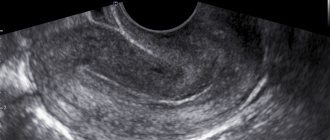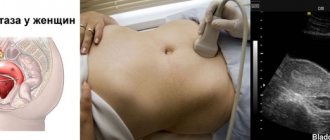Call the clinic +7 928 828 4001
Prices for services
| Service | Price |
| Consultation with a gynecologist | 1350* ք |
| Consultation with the head of the gynecological department Bogdanovich I.F. | 1800* ք |
| Consultation with the head of the department of laser gynecology Androsova O.V. | 1800* ք |
| Dopplerography of blood vessels in pregnant women | 1500 ք |
| Ultrasound of the fetus up to 10 weeks of pregnancy | 1700 ք |
| Ultrasound of the fetus from 10 weeks of pregnancy with assessment of MPC | 2400 ք |
| Ultrasound of multiple pregnancy | 3500 ք |
| Echosalpingography (tubal patency) | 5500 ք |
| Ultrasound of the pelvic organs in women (TA, TV) | 1400 ք |
| Ultrasound of the pelvic organs with Dopplerography of the uterine arteries and myometrium | 2000 ք |
| Cervicometry | 1000 ք |
| Folliculometry (per visit) | 1300 ք |
| Echocardiography (ultrasound of the heart) of the fetus | 2400 |
Cervicometry is a procedure for measuring the length of the cervix using ultrasound. It should be clarified that the cervix plays the role of holding the fetus in the body and excludes termination of pregnancy before the due date. But sometimes it happens that the cervix relaxes and shortens ahead of time. This often happens due to the muscle tone of the uterus. It is cervicometry that will allow timely identification of the problem using ultrasound examination; this type of procedure is important and the examination should not be skipped; correct treatment will help preserve the pregnancy and allow it to develop intrauterinely to its due date.
What's happening
At the 16th week of pregnancy, the length of the fetus will reach 11 - 11.5 cm, and the weight will be 80 g. All vital processes are actively going on in the body of the little man: the heart is working hard, the kidneys are regularly excreting urine, the development of the central nervous system continues. By 15–16 weeks of pregnancy, the composition of the fetal blood has already taken shape: it, as it should be, consists of lymphocytes, erythrocytes and monocytes. It contains fetal (or “fetal”) hemoglobin: it is needed for a better supply of oxygen to cells, and in a newborn its share is about 80 - 85% of the total amount. However, already at this stage, “adult” hemoglobin appears - within six months after the birth of the child, it will replace the fetal one.
By the 16th week of pregnancy, the baby’s muscles have already become sufficiently strong, he has learned to hold his head straight and turn it from side to side, and move his fingers and toes. Your baby is very active: he smiles, frowns, yawns, swallows, spits, sucks his thumb and even tries to play with what he finds nearby: he grabs the umbilical cord, touches his arms and legs. And if there is more than one baby in the mother’s belly, the children communicate with each other.
Does every pregnant woman need to undergo a second screening?
According to the order of the Ministry of Health, prenatal screening in the second trimester of pregnancy is not indicated for all women. Its completion is mandatory in the following cases:
- the presence of changes or suspicions of the development of pathologies during the first planned examination;
- the age of the expectant mother is more than 35 years;
- consanguineous marriage;
- history of genetic abnormalities;
- threat of miscarriage;
- infectious diseases during the first trimester;
- taking medications prohibited during pregnancy;
- alcohol and drug use.
Ultrasound is generally performed on all pregnant women. This is due to the fact that at this stage the formation of important functional organs and systems occurs in the fetus. In the second trimester, ultrasound examination is carried out only transabdominally (through the skin of the mother’s abdomen).
How you feel
During the 15th – 16th week of pregnancy, the uterus grows and stretches the muscles and ligaments in the lower abdomen, which is why you may feel minor pain. Now the uterus has grown so much that it can already be felt: to do this, empty your bladder, lie on your back and relax. Now try using your fingertips to gently explore the area in the middle of your abdomen, just above your pelvic bone. The protruding area is your unborn child. If nothing works and you cannot feel the uterus, ask your doctor to teach you how to do it correctly.
At the 16th week of pregnancy, due to compression of the intestines, problems with going to the toilet “in a big way” may appear. If we were talking only about discomfort, it would not be so scary, but prolonged constipation can increase the risk of miscarriage. Therefore, it is imperative to review your diet and include foods that have a laxative effect. To prevent problems with peristalsis in the 15th – 16th week of pregnancy, it is advisable to do simple physical exercises every day and walk in the fresh air, and it’s also a good idea to visit the pool.
Your breasts continue to enlarge and your areolas become even larger and darker. The hormonal surge has ended and your appetite has increased. However, you must try not to overeat and constantly monitor your body weight. Normal weekly weight gain ranges from 300 to 500 g.
And at the stage of 15 - 16 weeks of pregnancy, your temperature may increase by 1 - 2 degrees. There is no need to worry: the body “overheats” due to intense work, and with the help of increased sweating and a feeling of heat, the body cools itself. The amount of vaginal discharge may also increase. Increased secretion is a kind of preparation of the genital tract for childbirth.
In general, the 16th week of pregnancy is a period when a woman’s emotional state normalizes and her energy returns. A thirst for vigorous activity appears: you want to start renovations, large-scale shopping, or even moving. But the expectant mother should be careful - not to lift weights and not to overwork, because this can negatively affect the health of her baby.
Lifestyle
If worries and fears about pregnancy still haunt you, now is the best time to take up yoga. It is believed that yoga for pregnant women is a set of the most gentle and safe physical exercises for expectant mothers. Special positions (asanas) help cope with feelings of anxiety and relieve emotional stress. During classes, a woman learns to control her breathing, relaxes, “unloads” the spine and... communicates with other expectant mothers, which is also important.
Risk factors
If pregnancy develops without pathologies and complications, there should not be any particular unpleasant sensations at this stage. With prolonged physical activity, you may experience pain in the lower back or legs, but in no case in the lower abdomen.
At the 16th week of pregnancy, the risk of developing iron deficiency anemia increases. This is due to an increase in the volume of circulating blood and a decrease in the number of red blood cells in it. To compensate for iron deficiency, the gynecologist may prescribe medications containing this element. Also, in the blood of the expectant mother, when the period has reached 16 weeks of pregnancy, a lack of calcium and magnesium is often detected, which is fraught with the appearance of cramps in the legs (most often at night). In this situation, special magnesium preparations will help, and to replenish the daily need for calcium, it is enough to eat a little cottage cheese and drink a glass of kefir or milk every day.
Discharge at 16 weeks of pregnancy is white or yellowish and practically odorless. When they cause itching, have a strong odor and turn green, these may be symptoms of a genital infection that must be treated. And if the discharge turns brown, pink or red, this is a cause for serious concern. In combination with cramping pain, a feeling of tightness in the lower back and a “petrified” abdomen, they can be a sign of uterine hypertonicity. Take a lying position and immediately call an ambulance.
Beauty and accessories
Every week a woman's belly becomes bigger and bigger. Worried that new sizes will make you less attractive? Don't worry: maternity clothing manufacturers follow fashion trends, so you'll always look stylish if you want. Pay attention to movie and show business stars: many of them do not hide their belly; on the contrary, they emphasize it, choosing tight models even during an “interesting position.” Follow their example, don’t hide your changed status, be proud of it, because very soon you will become a mother!
Medical observation
At the 16th week of pregnancy, in addition to a general blood and urine test, you may have to donate blood for a coagulogram (to determine its coagulation), free estriol, AFP and hCG. With diseases such as Down syndrome, cranial hernia and anencephaly, the level of these substances will deviate from the norm.
Usually an ultrasound is not performed at 16 weeks of pregnancy, but if one is prescribed, the expectant mother will be able to observe on the monitor not only the movements of her baby, but also his facial expressions. This time, using a regular ultrasound machine, you can determine the sex of the child, if, of course, your baby turns the right way.
In some cases, amniocentesis is prescribed at the 16th week of pregnancy. For this test, a puncture is made in the amniotic sac and a small amount of amniotic fluid is removed using a needle. A diagnostic test allows you to determine with almost absolute certainty whether the fetus has a particular pathology. This study can identify several hundred genetic defects. But this procedure is unsafe: according to statistics, infection occurs in one case out of a thousand, and the risk of miscarriage as a result of amniocentesis is approximately 0.5 - 1%. Therefore, unless absolutely necessary, it is better not to puncture the amniotic membrane at the 15th - 16th week of pregnancy.
What does an ultrasound of the cervix show during pregnancy?
Ultrasound of the cervix shows:
- Level of cervical tone. Its increase indicates that there is a threat of premature delivery.
- The size of the cervix, as well as its shape. Depending on the stage of pregnancy, these indicators should change. Deviation of actual values from standard values indicates a pathological condition.
- The composition of the cervix (or its consistency) and its density.
- A hole in the cervix (or its absence, which is normal). If the pregnancy is going well, the cervix remains closed until the very last weeks. In the last weeks, when labor begins, it begins to gradually open. If the ultrasound shows premature opening, then the attending physician may prescribe a special procedure for the pregnant woman - suturing to tighten the walls of the cervix. Otherwise, the hole in the cervix can lead to early labor (before the due date).
- Condition of the cervical canal (its patency, length, expansion, etc.).
- Presence of cervical pathologies. These could be, for example, erosion, polyps or cysts. In some cases, when such pathologies can harm the course of pregnancy, the attending physician may prescribe a surgical operation to remove the pathological element.
Ultrasound can also be used to assess the risk of cervical rupture. Here, women who have previously had a caesarean section are at risk. Cervical rupture can lead not only to disruption of the current pregnancy, but also to further infertility.
Decoding the results
Interpretation of the results of ultrasound of the cervix is carried out immediately after the examination. Ideally, in the ultrasound report, the doctor writes “without pathologies,” which means that the pregnancy is proceeding normally.
Unfortunately, ideal cases nowadays do not occur as often as we would like. When deciphering the ultrasound results, the doctor can make a conclusion about the deformation of the cervix, the unevenness of its consistency, low density, short length (inappropriate for the established gestational age), and so on.
Norms and indicators
There are certain standards for ultrasound of the uterus during pregnancy.
, by which the condition of the cervix is assessed:
- Cervical length. In the first trimester, this indicator has a normative value of 35-45 mm. The longer the pregnancy, the shorter the cervix becomes. If the first screening reveals that the length of the cervix is less than 20 mm, isthmic-cervical insufficiency is diagnosed. This pathology leads to miscarriage - miscarriage.
- Density. In the early stages of gestation, the cervix is highly dense. The closer to childbirth, the lower the density.
- Cervical maturity. This indicator involves a point assessment. Immaturity is assessed at 0-3 points, insufficient maturity – 4-6, mature cervix is assessed at 7-10 points.
Recommendations
- For the 16th week of pregnancy, the recommendations remain the same. Now it is important for you to monitor your weight gain. And to avoid obesity, it is necessary to exclude “fast” carbohydrates (baked goods, cakes, chocolate, candies) from the diet. Extra pounds can lead to complications and negatively affect the birth process. When you are already 16 weeks pregnant, eat right: don’t skip breakfast, choose nuts, fruits, biscuits, and natural sugar-free yoghurts as snacks. And at night you can drink herbal tea with honey or a glass of kefir;
- Some pregnant women are interested in the question of whether it is possible to visit a bathhouse or sauna during the 15th – 16th week of pregnancy. You should not do this: like a hot bath or shower, bath procedures can harm the baby, because if your body temperature rises even for a few minutes, great damage will be caused to the baby’s body.
How to prepare for the examination?
In practice, several methods are used to conduct an ultrasound of the cervix (as well as the scar on the uterus) when monitoring pregnancy:
- The transvaginal method
involves the use of a special vaginal sensor, which is placed in the vaginal cavity during examination. This procedure does not require special preparation. - Transabdominal
. Before such a procedure, it is recommended to refrain from eating food that contributes to excessive gas formation in the intestines for 2-3 days. - Transrectal method - examination of the cervix through the anus. Before such an ultrasound, it is necessary to do a cleansing enema. Pregnant women are rarely prescribed such an ultrasound; it is more acceptable for virgin girls.
- Ultrasound through the skin of the perineum. No preliminary preparation is required.
Norms (indicators) of fetal development by the 16th week of pregnancy
The most important factor in diagnosing pathologies in the fetus is the compliance of ultrasound examination parameters with accepted and approved standards in obstetrics. At the beginning of the fourth month they should be as close as possible to the following numbers:
- weight: 90-120 g;
- length from crown to tailbone: 10-12 mm;
- head circumference: 110-135 mm (optimal average size - 124 cm);
- abdominal circumference: 88-115 mm (average 100 mm);
- femur length: 17-24 mm;
- humerus length: 15-22 mm;
- forearm length: 12-19 mm;
- ankle length: 15-22 mm;
- head length across (BPR): 31-38 mm.
As you can see, the size of the fetus is a rather arbitrary indicator that depends on many parameters, such as the constitution and height of the parents, gender, and the accuracy of the deadline. Therefore, to assess the correct development and the absence of pathological deviations, factors such as the correct proportions, the same length of the right and left pairs of limbs, the normal number of fingers, their phalanges, the baby’s mobility, etc. are also taken into account.








